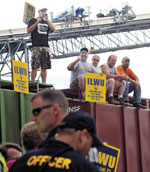
Showdown on West Coast Docks: The Battle of Longview
(November 2011).
click on photo for article
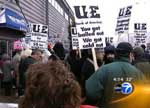
Chicago Plant Occupation Electrifies Labor
(December 2008).
click on photo for article
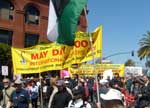
May Day Strike Against the War Shuts Down
U.S. West Coast Ports
(May 2008)
click on photo for article

August 2023
Vote
“NO” and Strike for $25 – Plus AC – NOW!
Next Up: Organize Amazon!
Teamster-UPS Deal:
No End to Poverty Pay
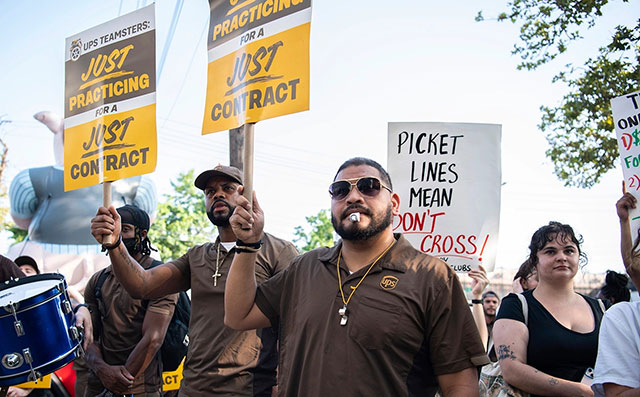
UPS Teamsters demonstrate their power, July 6, at Foster Ave., Brooklyn, New York City. (Brittainy Newman / AP)
AUGUST 6 – On July 25, a week before a strike deadline for which the union had been preparing with a lot of fanfare for more than a year, the International Brotherhood of Teamsters (IBT), representing 340,000 United Parcel Service (UPS) drivers and warehouse workers, suddenly announced that it had reached a tentative agreement with the company, averting a strike. IBT general president Sean O’Brien proclaimed the deal “the most historic tentative agreement for workers in the history of UPS.” He added, “We’ve changed the game.” But the members still get to vote on it.
Last fall, O’Brien declared, “This UPS agreement is going to be the defining moment in organized labor.” Immediately after the tentative agreement (TA) was announced, various Democratic Party politicians (Bernie Sanders, Nancy Pelosi, Alexandria Ocasio-Cortez, of course), labor liberals (Labor Notes) and reformist leftists rushed to congratulate the Teamsters for their negotiating “victory.” Interestingly, the big business press also hailed the outcome. So after all the hype, what did this defining, game-changing, most-historic-ever TA actually win?
Under the agreement, all current Teamsters would get raises of at least $7.50 per hour, by 2028. For drivers earning top rate, currently $42 an hour, that would just be an 18% increase. Spread over five years, at the rate prices have been rising lately, that would almost all be eaten up by inflation. Some 7,500 new full-time positions will be opened up, but even for full-time drivers, starting pay will be a miserly $23/hour, achieving full pay only after a four-year “progression.” And many part-time workers who believed O’Brien when he said the union would fight for $25 an hour minimum were disappointed to learn that starting pay for part-time new hires would only be $21, later increasing to $23.
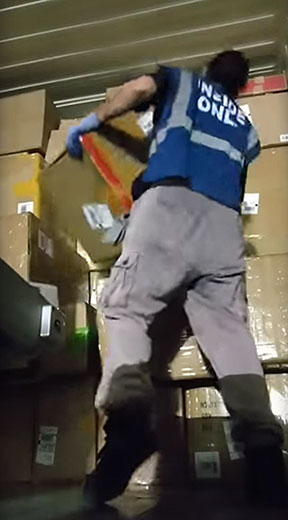 Wrestling boxes, large
and small, is a backbreaking job. UPS warehouse worker
loading a truck in 2019. At the time she was earning the
contractual rate of $13 per hour! UPS makes millions off
of low-paid part-time labor. Teamsters must demand equal
pay for equal work. (YouTube)
Wrestling boxes, large
and small, is a backbreaking job. UPS warehouse worker
loading a truck in 2019. At the time she was earning the
contractual rate of $13 per hour! UPS makes millions off
of low-paid part-time labor. Teamsters must demand equal
pay for equal work. (YouTube)The fact that for many low-wage part-timers, $21-$23 represents a significant raise from the current starting pay of $16.20 an hour is an outrage in itself. UPS is squeezing fabulous profits from such sweatshop wages, yet this is the fault of the Teamster leadership which for over four decades has agreed to such miserable pay. (Actually, starting pay in the current contract is $15.50, up from the ridiculous $13 in 2018! The increase to $16.20 was due to a mandate for companies that contract with the federal government.) But $21/hr. is still poverty pay. You can’t live on that. And with a guaranteed minimum shift of only 3½ hours, part-time workers can only, barely, make ends meet with a second and even a third job.
Union officials are pushing the line that part-time pay will eventually rise to $25.75 (by 2028, and not for new hires). But already in a number of areas, UPS uses “market rate adjustments” to raise part-time pay ($24-25/hr. in the Boston area, $20.50 in areas of southern California) because they can’t get enough workers at their miserable contractual rate. In New York, with huge numbers of working people desperate to pay the rent and food, the pay is still rock bottom. This is doubly and triply important because at $21 an hour, UPS wages will only be slightly above Amazon’s, which is now paying $19, undercutting the IBT’s talk of unionizing the e-retail giant, and therefore the drive to organize the whole of the package delivery industry.
Another “hot” issue at UPS has been air conditioning, particularly after the heat wave last year. Now we are in what could be the hottest year on record. In June, the union and company announced a preliminary agreement. “Air conditioning is coming to UPS,” said O’Brien. So what was in the TA on this? It turns out package cars will get two fans in the cab, while “newer non-electric” delivery vehicles would be gradually retrofitted with induction vents, and starting next January, newly purchased package cars will have in-cab air conditioning. That is supposed to be heat safety?! At UPS, famous for keeping its vans on the road for up to 30 years, it could be 2053 before all its delivery vehicles have AC. As for the warehouses, nothing. Keep on sweating.
Internationalist supporters in the Teamster-UPS
division have called for at least $30 an hour
starting wage, to break the cycle of poverty
pay and give a push to the Teamsters’ campaign –
launched two years ago but so far going nowhere – to
unionize the more than 800,000 production workers at
Amazon. As rumors circulated that IBT negotiators were
backtracking on the $25/hr. demand, at Teamster contract
rallies and “practice pickets” in June and July,
Internationalist signs declared: “Teamsters
One-Two Punch: 1) $25+/hr. Minimum for UPS Part-Time
Workers, 2) Organize Amazon!”
Now, in the face of an utterly inadequate Tentative Agreement, we urge UPS Teamsters to: Vote “NO” and Strike for $25 – Plus AC – NOW! To actually wage and win a strike, particularly after the union leadership agreed to a deal that would preserve poverty pay for part-timers, who are the absolute majority of UPS workers, Teamster militants should demand that there be an elected strike committee, with hundreds of delegates who can be recalled at any time, representing every local with UPS workers, to organize and decide on the course of the strike.
Despite the push for a “yes” vote coming from Teamster headquarters in Washington about the “historic” contract, it can be voted down. The 2018 UPS contract was defeated, but then imposed by Teamsters president James Hoffa Jr., using a provision of the IBT constitution going back to 1940 requiring a two-thirds majority to defeat a contract agreed to by the leadership.1 That clause was overturned at the 2021 Teamster convention. The previous (2013) contract barely passed, with only a 53% majority voting for it. In both cases, less than half the membership voted, and a much smaller percentage of part-time workers. Turnout is key. Voting on the contract is from August 3 to August 22.
If the TA is voted down, the logical next step would be an all-out strike. That would be a battle royal between labor and capital, the likes of which the U.S. hasn’t seen for years. To carry out and win the kind of struggle that workers at UPS – and elsewhere – need, that battle has to be waged politically. Labor's power must be unchained from the bosses’ parties. Joe Biden has declared himself to be the most pro-labor president ever, but it was the Democrats – Biden, Pelosi, Sanders and AOC’s “Squad” – who (with lots of Republican support) carried out blatant strikebreaking against the railway workers last December. As union leaders provide cover for Biden & Co., this highlights why workers need to break completely with all capitalist parties.
It also underlines the need to build a class-struggle leadership of the unions, and to forge a workers party to lead a struggle of all the oppressed to replace the brutal rule of capital – UPS, Amazon, the banks, real estate and the rest – with the liberating rule of a workers government. For them, we’re just a source of profit: they figure they can work us to death in the stifling heat while tossing us a few crumbs to keep us quiet. Their system runs on exploitation, racism and war, but the working class has the power not just to win a strike but to put the wealth we have created in the service of human needs. Only a leadership committed to such a workers revolution will be up to the job of decisively defeating UPS and the others who live off our labor.
Bosses’ Press Praises Teamster-UPS Agreement
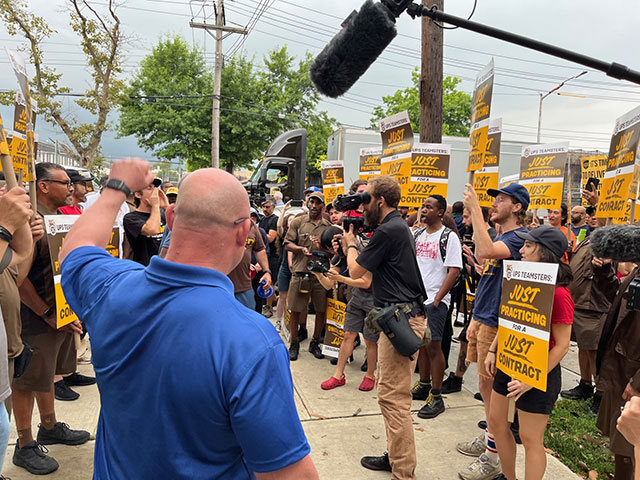
IBT general president Sean O'Brien joins UPS Teamsters and supporters on “practice picket” line at Foster Ave., Brooklyn, July 14. Teamster tops vowed to fight for $25 part-time wage, delivered poverty pay. (Teamsters / Twitter)
Over the last few years, working people in the United States and internationally have gone through rough times. The COVID-19 pandemic officially killed well over a million people in the U.S. and 7 million worldwide (in reality, much more), while millions lost their jobs and many their homes. This was followed by galloping inflation – driven by rampant profiteering by giant corporations and intensified by U.S. sanctions against Russia – reaching the highest level in 40 years in mid-2022. And as the cost of living shot up, workers’ real wages (after subtracting for increased prices) plunged by over 8% last year, the most severe drop in a quarter century. So as 2023 began, many were fed up and ready to fight.
By spring, as Hollywood screen writers walked out on May 2, followed by actors in early July, there was wide anticipation of a “Strike Summer,” which could extend into “Strike Fall.” In particular, after contracts of powerful rail and dock unions, whose members labored in dangerous conditions through the pandemic, expired last year, the August 1 deadline for the Teamsters’ UPS contract looked like it might be the big one. After all, IBT president O’Brien had been talking strike since before he took office in 2021. Some pro-labor media said a UPS walkout “could be the biggest strike in U.S. history” (More Perfect Union, 31 May). Expectations were sky-high.
On July 5 – after O’Brien had set a deadline to reach a settlement by that date – bargaining broke down. The union said on Facebook that the company “shamelessly” presented an “unofficial offer” that would force “part-time workers at UPS to be left behind.” Stressing that part-time employees earn “near-minimum wage” in much of the country, the IBT leader declared, “part-time poverty isn’t working for America.” Already in mid-June, the UPS members had voted by 97% to authorize a strike, and over the next two weeks, UPS locals around the country held “practice pickets.” So, many were surprised when three weeks later, company and union negotiators, after a brief meeting, issued statements that a deal had been reached.
Significantly, the bosses’ press praised the UPS settlement. The Wall Street Journal (25 July), the voice of high finance, opined in an editorial (“UPS and the Art of the Teamster Deal”) that “the UPS wage hikes are catching up with recent inflation more than they are driving more price increases,” that “the public” (meaning the money men) “wins when a strike is averted,” and that the deal will allow UPS “greater flexibility” in scheduling weekend shifts. The industry publication Freight Waves (25 July) was more specific, quoting an analyst who said the agreement could open the door for the UPS and IBT to “negotiate 7 day a week service mid-contract without opening up the entire contract to do so,” including working on Sundays.
A perceptive labor reporter, Norm Scheiber, writing in the New York Times (26 July), that house organ of the capitalist/imperialist establishment, quoted UPS chief executive Carole Tomé saying on an earnings call with investors last spring that they should not be distracted by the “great deal of noise during the negotiation” on the way to a “win-win-win contract” by the end of July. A few days prior (22 July), Schreiber noted, which many on the left were blind to, that “for all his pugilistic statements, Mr. O’Brien remains an establishment figure who appears to prefer reaching a deal to going on strike, and he has subtly acted to make one less likely.” Which is exactly what happened.
First Rail, Now UPS: Teamster Leader O’Brien Averts a Strike, Again
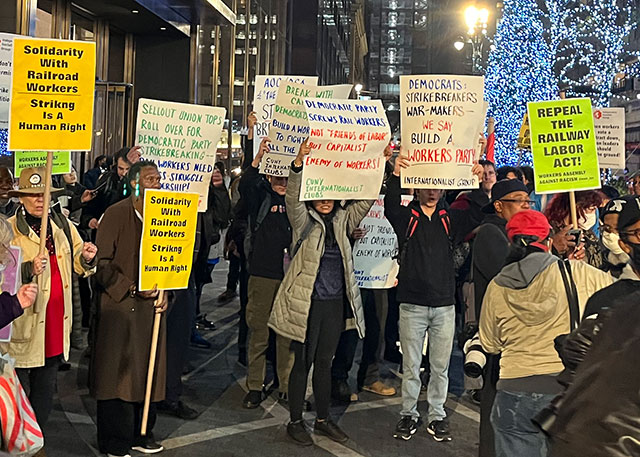
Solidarity with railroad workers demo against government strikebreaking, at New York City's Grand Central Station, 8 December 2022. Democrats: strikebreakers, war-makers – build a workers party! (Internationalist photo)
In 2021, the election of the Teamsters United slate, led by Sean O’Brien and Fred Zuckerman and backed by Teamsters for Democratic Union (TDU), replaced the regime of James Hoffa, Jr., which had led the Teamsters for 24 years. O’Brien was a long-time Hoffa lieutenant at the head of IBT Local 25 in the Boston area. Zuckerman is the former president of Local 89 in Louisville who was narrowly defeated by Hoffa Jr. in the 2016 IBT election. And the TDU is a reputedly left caucus in the IBT going back to the 1970s, when it was started by sellout social democrats who made their mark by appealing to the federal government and suing the union in the courts. This violates the basic labor principle of independence from the bosses’ state.
Hoffa Jr. replaced the TDU-backed regime of Ron Carey, which led a national strike at UPS in 1997. That two-week strike, very popular throughout the country, won modest gains in pay and pledges to convert some 10,000 part-time workers, then two-thirds of the workforce, into full-timers. But that conversion created a tier of “22.3” workers who are paid $6.00 less than other full-time employees. That tier has continued through all the UPS contracts since then, including the new TA. (This is distinct from the 22.4 tier created under the 2018 contract who get paid even less, which O’Brien/Zuckerman vowed in their election campaign to get rid of, allowing them to pose as “militants.”)
Carey had come to office through government-run elections that resulted from a 1989 Justice Department consent decree which the union-suers of the TDU pushed for in the name of “union democracy.” Beholden to the bosses’ government, in 1994 Carey caved in to federal “mediation” under Democrat Bill Clinton in the Master Freight Agreement with trucking companies, costing 40,000 Teamster jobs. Also in ’94, he called off a strike at UPS after one day. When Carey was forced into a serious strike at UPS in 1997, immediately afterwards the chickens came home to roost as the feds brought charges against him, ordering new elections in which he could not run. Hoffa Jr., representing the old guard of the bureaucracy, became general president in 1998.
The conclusion, as we have written elsewhere, is: “Bring in the feds and they own you” (“Unionize Amazon with Class Struggle,” in The Internationalist No. 65, October-December 2021). For our special supplement on the 1997 UPS strike, see “Teamsters Strike Against UPS: All Out to Win This Fight!” (4 August 1997) in The Internationalist No. 2, September-October 1997. For more on how government intervention, aided and abetted by the TDU, wrecked IBT pension funds, see “How Feds Destroyed Teamster Pensions,” on page 8.
When O’Brien and Zuckerman were elected in 2021, this was hailed by Labor Notes (which came out of the late-’70s upsurge of the TDU and similar caucuses in steel and auto) and various reformist leftists. Teamsters for a Democratic Union declared a “new era,” and effectively became part of the O’Brien-Zuckerman (“OZ-TDU”) administration. O’Brien, who was IBT eastern region vice president under Hoffa, Jr., talked tough against UPS – vowing at the October 2022 TDU convention to “pulverize” Big Brown. But it was a different story with the rail unions, where two Teamsters affiliates, BLET (engineers and train workers) and BMWED (maintenance of way workers) represent three-quarters of all unionized railroad workers.
As railroad bargaining revved up in mid-2022, O’Brien got his pal Marty Walsh – a former construction union leader who became mayor of Boston and then President Biden’s secretary of labor – to get a Presidential Emergency Board (PEB) appointed under the 1926 Railway Labor Act, which lets the federal government ban rail strikes. On the PEB’s orders, the IBT and other rail union tops agreed to a contract without the sick days that the ranks had insisted on. And the OZ-TDU Teamsters leadership went along when Biden and the Democratic Congress – including AOC and the other DSA (Democratic Socialists of America) Democrats – rammed through a bill banning a strike and imposing contract on rail workers that a majority voted against.2
“Throughout negotiations,” said an IBT release, “O’Brien worked closely” with Biden and Walsh “to reach an agreement that kept Teamsters working and America’s rails running” – that is, to prevent a strike. On the UPS contract, O’Brien said he wanted Biden to stay out. This shows how unpopular the rail contract fiasco was with the membership. A strike at UPS, which moves 6% of all domestic production, would be a huge disruption to the economy, and when O’Brien settled, he was thanked by Biden for averting a strike, again.
Fight for a Program That Points the Way to Workers Rule
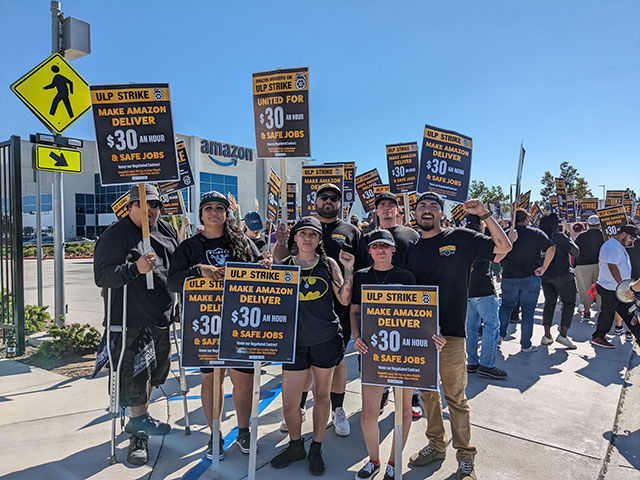
Amazon delivery drivers affiliated with Teamsters Local 396 picketed outside ONT1 sort center, Mira Loma, CA. (Photo: Teamsters Local 396)
Among the gains highlighted by the Teamster bureaucracy as it tries to sell the UPS tentative agreement is the elimination of the “22.4” tier. This was originally billed as being for “flexible,” “hybrid” indoor-outdoor workers, but in reality, it was just another tier of lower-paid drivers. The fact that those workers will now be regular package car drivers is a step forward, but under UPS’ “progression” rules, they will only reach full rate in four years, with puny raises in the first three years. Moreover, a new de facto tier of future part-time hires will only get a $2 raise over the course of the contract, while existing part-timers get another $2.75. These tiers are used to divide workers. We say: To hell with “progression” – abolish the tiers – full pay for all, now!
The terrible situation of part-time workers is key to the condition of all UPS workers, and to the company’s profits. Some 55% of the UPS workforce in the U.S. is part-time. In New York, under the current contract most part-time workers make a little over one-third the rate of full-time drivers. Lower pay for part-time workers was originally imposed in a contract in 1982, during a deep economic recession with 11% unemployment and the bosses on a rampage after busting the PATCO air controllers union. Part-time starting pay was reduced by 25%, to $8 an hour – and it stayed close to that for three decades! With inflation, $8 would today be $25, so under the new TA, part-timers would still make far less than the cut-rate pay of 40 years ago!
The reduced part-time wage led to a massive expansion of part-time workers and huge profits for UPS in the following decades. In 2018, a Teamster negotiator said union leaders had gone along with “artificially low” starting pay for part-timers for 36 years with the justification that it allowed for higher pay for full-timers and for senior workers – as if the top rate for drivers were something to brag about. Even the 1997 strike, under the slogan “Part-Time America Won’t Work,” left the huge pay gap. And today the creation of 7,500 full-time (22.3!) jobs is a drop in the bucket when there are 180,000 UPS workers stuck in the part-time trap. UPS workers should demand: Equal pay for equal work – and full-time jobs for all who want them.
Then there are the brutal split shifts. The “22.3” full-time positions coming out of the 1997 were created by combining part-time shifts, but many of these shifts are not continuous. A large number resulted in split shifts, separated by several hours, so that a warehouse worker on a 4-9 a.m. preload shift might also have a 6-10 p.m. twilight shift. Some sleep at work between shifts and may go home only once a week. Now there are rumors that even more 22.3 workers will be put on split shifts. These conditions are intolerable, a throwback to non-union days. The 8-hour day, 40-hour workweek were supposedly won almost a century ago. UPS workers should demand: end split shifts!
UPS raked in record profits of $26 billion in 2021-22. Its adjusted operating profit last year was 66% above its pre-pandemic level. Its profit rate (return on invested capital) was 31%. Plus last year it handed out $8.6 billion to shareowners (led by the Wall Street behemoth BlackRock) in the form of dividends and share buybacks. In short, United Parcel Service is rolling in dough. The Teamsters are in an extraordinarily strong position to strike, and would enjoy huge popular support as workers earning as little as $16.20/hr. take on a company whose CEO makes more in a day ($19,000,000 ÷ 365 = $52,000) than most UPS workers earn in a year. It would not be hard to explain, and for millions to understand, that UPS Teamsters are striking for all of us!
Even in less favorable conditions, with a leadership fighting on a program of militant class struggle the Teamsters could sock it to UPS. But that can’t be done with a “business union” leadership that the OZ-TDU “team” represent no less than Hoffa Jr., all of whom recognize the bosses’ “right” to exploit workers. Rather than accepting the “logic” of capitalism, union militants should raise a series of “transitional demands” pointing to a struggle for workers rule. Take forced overtime. The new TA says no one will be required to work six days a week. This is just going back to the past. UPS workers should not have to put in long hours at all. They should demand a shorter workweek with no loss in pay (“30 for 40”), creating a lot of new jobs.
This demand for a sliding scale of working hours should go hand in hand with a fight for a sliding scale of wages, automatically raising wages to make up for the rising cost of consumer goods. UPS Teamsters have a “cost-of-living” adjustment (COLA), which is rare enough these days, but it only provides piddling compensation. The way it works today, it only kicks in when the increase in the Consumer Price Index is over 3% a year. So if the official annual inflation is 4.9% (as it was in April), then the COLA would be all of 28 cents. As they said ironically in the ’30s Depression, “don’t spend it all in one place.” UPS Teamsters should demand a full COLA, based on union calculation of the actual inflation rate.
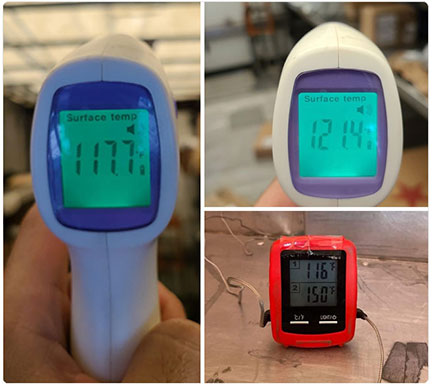 UPS drivers share
thermometer readings of near 120° (and over) heat in
their trucks, with surface temperatures of 150°, August
2022. Demand UPS install air conditioning now. (Photo: TDU / Twitter)
UPS drivers share
thermometer readings of near 120° (and over) heat in
their trucks, with surface temperatures of 150°, August
2022. Demand UPS install air conditioning now. (Photo: TDU / Twitter)Or take air conditioning. This has become an urgent issue as killer heat waves roll across the U.S. In June 2022, Esteban Chavez Jr. died of an apparent heat stroke in his truck in Pasadena, California, and in October 2021 23-year-old warehouse worker Jose Cruz died of heat exhaustion on the job in Waco, Texas. Videos have gone viral of UPS drivers collapsing as they deliver packages, and of workers documenting 120° heat (and 150° surface temperatures) in cargo areas of vans and package cars. Last month, Phoenix, Arizona set a record of 31 straight days of over 110°. But all that the new TA promises is a couple of fans and to start purchasing delivery vehicles with air conditioned cabs next January.
That is no answer at all to the heat crisis. There is no reason for such a delay except one: money, and not a lot of that. Workers should demand that UPS put roof-mounted units on its delivery vehicles, starting now! At $750 to $3,000 (for top-of-the-line models) apiece, to a company of UPS’ size, that is chicken-feed. (No doubt UPS bosses would object to the fuel costs of keeping the engines running. That’s their problem: if they want packages delivered, they’ll eat it.) And demand that when temperatures in UPS warehouses go over 90°, production stops. To enforce this, there should be union safety committees empowered to shut down operations in unsafe conditions.
As Leon Trotsky, co-leader together with Lenin of the Russian October Revolution of 1917, wrote in the Transitional Program, the founding document of the Fourth International, such measures, and others such as to open the books for workers inspection and workers control of industry, point to the need for a planned economy based on production for human needs rather than the tyranny of the market based on production for profit. To accomplish that requires expropriation of the capitalist class by a workers government. To be sure, we have a ways to go to get there, but a solid strike can be an excellent school for socialism. And that poses point-blank the crisis of working-class leadership.
Build a Class-Struggle Opposition in the Teamsters
At the July 31 meeting in Washington of leaders of Teamster UPS locals, the vote was 161 to 1 to endorse the TA (only Local 89, Zuckerman’s home local, voted against). There have been reports of considerable discontent, particularly (but not only) among part-time workers, many of whom believed that O’Brien was hard-lining it for a minimum $25 an hour wage. One group, Teamsters Mobilize, has called to “Vote NO” on the deal, demanding (in addition to the $25 base part-timer pay) that all market rate adjustments be permanent, full-time wages for all 22.3 workers, getting rid of surveillance cameras and some other correct demands. The freeze of pension contributions other than for the IBT-UPS and New England plans is another sore point.
Since the 2016 upsurge in votes for the populist Democrat presidential primary contender Bernie Sanders, which led to a huge influx into the Democratic (Party) Socialists of America, a significant number of young DSAers found their way into UPS. Many have since become active parts of the OZ-TDU regime. Moreover, although the DSA professes to have a “rank-and-file strategy” in the unions, it has been actively recruiting officials at different levels of Teamster officialdom. As a result, many of those who are today singing the praises of the UPS deal are these professed “socialists” ensconced in the union bureaucracy and the capitalist party of warmongers and strikebreakers Biden, Sanders and AOC’s “squad.”
When the TA was announced, the DSA quickly issued a statement hailing the Teamsters’ “historic contract campaign,” vowing “unflinching solidarity” with the ranks “as they vote to accept or reject the TA.” Very helpful. Other groupings in and around the DSA have called to vote “no,” including Workers Strike Back, an outfit spawned by Socialist Alternative (SAlt).3 The most that the Tempest Collective,4 another tendency in the DSA, could do (so far) was to reprint an article by Joe Allen, a former UPS worker and author of The Package King: A Rank and File History of UPS (2020), lamenting that “it feels like a moment has been missed for real historic victories.”5
Left Voice (LV, U.S. affiliate of the Trotskyist Fraction current) calls to vote “no” while holding a joint forum with Tempest. The professional tailists of LV are so intent on chasing after one and another current in this “left” wing of the capitalist Democrats that they actually called on the DSA to lead a fight for a “no” vote: “The DSA, which has been organizing thousands of people to join practice picket lines and support UPS workers, should put all their strength behind supporting the workers who are fighting against the TA and for a better contract” (Left Voice, 28 July)! But the DSA is hardly an opposition in the Teamsters.
For its part, Cosmonaut, which leads the Marxist Unity Group inside the DSA, has published several well-informed articles calling to defend part-time workers and make $25 an hour a bottom-line demand, while exposing the betrayal of this centerpiece of the contract campaign by O’Brien and the TDU.6 But a group which is part of an organization (the DSA) that counts rail strikebreaker/Ukraine war budget supporter AOC and the host of DSA Democrat elected officials at local, state and federal levels as “comrades” cannot give revolutionary leadership to UPS workers. Why not? Because breaking with the Democrats and all capitalist parties and politicians is fundamental to any serious struggle against capital.
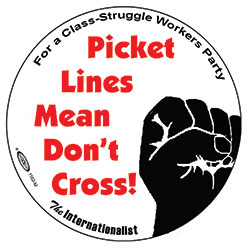 From the
picket line to a workers party, the class line is
fundamental.
From the
picket line to a workers party, the class line is
fundamental. To order buttons, click on image. (Internationalist photo)
All the groups in and around the DSA fail to (1) state clearly that overturning the IBT-UPS tentative agreement will require an all-out strike; (2) oppose TDU on principle for appealing to the capitalist state (Labor Department, courts, etc.) against the union; and (3) insist on opposition to the Democrats, and all the bosses’ parties. Whether they call to vote “no,” equivocate or remain silent on the contract, it is impossible to lead UPS Teamsters’ struggle forward to victory without taking a clear and emphatic position on these key questions. The duty of Marxist revolutionaries is to tell the truth to the masses, and the truth is that in order to prevail, the union must prepare its forces politically to take on a frontal assault by capital.
Outside the social-democratic constellation, the Party for Socialism and Liberation (PSL) published a full-throated endorsement of the UPS deal, declaring “UPS Teamsters’ victory shows how workers can fight and win!” (Liberation, 25 July). According to the PSL, “For organized labor to have real power, the most essential thing is to be prepared to strike” – not to wage a victorious class battle but only to “be prepared” to walk out. Like the DSA Democrats, these Stalinoid reformists orient to the union bureaucracy. Then there is the WSWS, which we have dubbed the World Scab Website, because while posing as leftists it actually sides with the bosses in opposing unions.7 They have no business being present at any labor struggle.
The various “critical” currents active around the Teamsters struggle at UPS basically have a program of (more or less) militant trade unionism. Some talk of a “rank-and-file strategy” while others espouse “social justice unionism,” but it’s all within the capitalist framework. The Trotskyists of the Internationalist Group call instead for class-struggle unionism, on the basis of a program calling to overthrow the system of exploitation and oppression of the “wage slaves” of capital. We say that there can be no “fair wage” or “fair contract” under the dictatorship of capital – it is necessary to break the chains that bind workers to the bosses. That requires that workers champion the cause of all the oppressed.
UPS had a mainly white workforce into the 1970s, but especially with the massive expansion of part-time work, it became a major employer of African American and Latino workers. UPS management has a long, dirty record of racist discrimination and harassment against black employees, going back decades and continuing today. In 2019, 19 black workers at a UPS warehouse in Maumee, Ohio, sued UPS over racist abuse, including nooses being hung at the workstation of a black worker. The union needs to mobilize to fight every instance of racist discrimination and abuse. Connected to this, fighting for the cause of part-timers is tied in with the struggle against UPS racism. So is the struggle to unionize Amazon.
Unionize Amazon with Class Struggle!
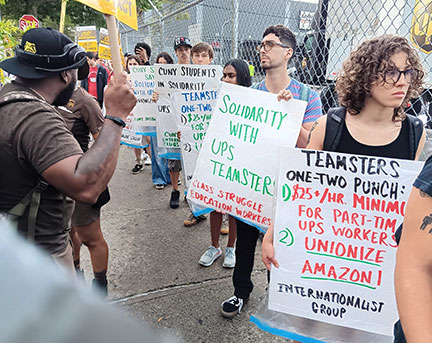 At UPS Teamster
practice picket in NYC, July 14 (Internationalist photo)
At UPS Teamster
practice picket in NYC, July 14 (Internationalist photo)Organizing Amazon was an issue in the national Teamsters election in 2021. O’Brien and the TDU said that their strategy was to show Amazon workers the benefits of a union by fighting for “strong contracts” when the DHL and UPS contracts expired in 2022 and 2023. We said at the time: “Winning major gains from the shipping bosses won’t come easy – it will take an all-out nationwide strike” (“Unionize Amazon with Class Struggle,” The Internationalist No. 65, October-December 2021). Instead, Teamster tops settled for utterly insufficient contracts and refused to strike when the membership was ready. It still is, but it needs leadership with the determination and program to fight to win.
That was what was key in the Trotskyist-led Minneapolis Teamster strikes of 1934. The flying pickets, mass, militant picket lines and policy of not relying on the capitalist state were able to defeat massive repression. That won the strikes, laid the basis for the workers defense guards that defeated fascist stormtroopers and later led to the organizing of over-the-road drivers. It went together with the struggle against the imperialist war drive, which is why IBT leader Tobin and the feds joined to jail the Minneapolis Teamster and Trotskyist leaders as the U.S. prepared to enter World War II. This struggle is detailed in the book Revolutionary Teamsters (2013) by Bryan D. Palmer, which we highly recommend for all labor militants today.
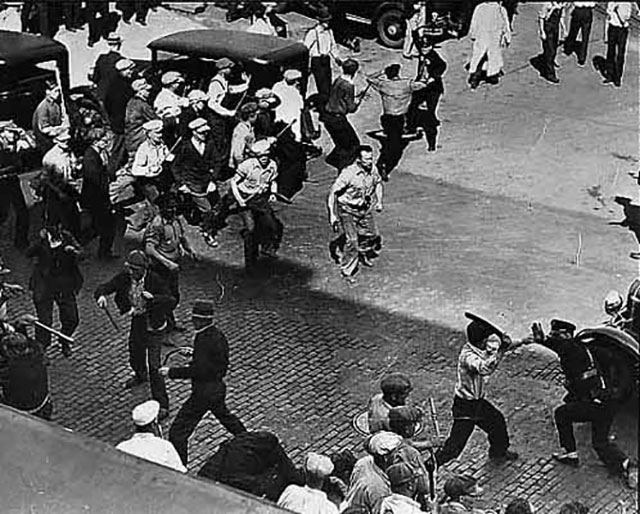
Trotskyist-led Minneapolis Teamsters disperse cops and scabs in “Battle of Deputies Run,” 21 May 1934. They weren’t practicing. Picket lines mean don’t cross! (Photo: Minnesota Historical Society)
In 1940, as WWII was underway, Trotsky wrote that in
this epoch of decaying capitalism, trade unions “cannot
any longer remain politically neutral…. They can no
longer be reformist, because the objective conditions
leave no room for any serious and lasting reforms. The
trade unions of our time can either serve as secondary
instruments of imperialist capitalism for the
subordination and disciplining of workers and for
obstructing the revolution, or, on the contrary, the
trade unions can become the instruments of the
revolutionary movement of the proletariat.” Trotsky’s
words are just as true today, as the capitalist world
hurtles toward a third, devastating imperialist world
war.
In his unfinished essay, which was on his desk as he was assassinated by a Stalinist agent, Trotsky added that the suppression of workers democracy in the unions was a function of “their drawing closely to and growing together with the state power.” This common feature of the trade unions was characteristic of both fascist and “democratic” imperialist countries as well as in the colonies and semi-colonies. Almost as if he were denouncing in advance the latter-day union-suers of TDU, who make a mockery of union democracy by appealing to the capitalist state, the Bolshevik leader wrote:
“The primary slogan for this struggle is: complete and unconditional independence of the trade unions in relation to the capitalist state. This means a struggle to turn the trade unions into the organs of the broad exploited masses and not the organs of a labor aristocracy.
“The second slogan is: trade union democracy. This second slogan flows directly from the first and presupposes for its realization the complete freedom of the trade unions from the imperialist or colonial state.”
–L.D. Trotsky, “Trade Unions in the Epoch of Imperialist Decay” (August 1940)
Carrying forward this program, Class Struggle Workers – Portland (CSWP) put forward and won resolutions in 2016 to break with the Democrats and all capitalist parties to form a class-struggle workers party, and then, following the victory of xenophobic, misogynist Donald Trump, to mobilize union power to smash racist forces. The next year (2017) this was carried out as hundreds of Portland-area unionists and supporters came out to stop a fascist provocation. Today, as in past years, the CSWP has won the support of unions to defend immigrants and the rights of transgender people against reactionary attacks. Not narrow trade-unionism but intransigent class struggle in defense of all the oppressed is what it will take to defeat UPS.
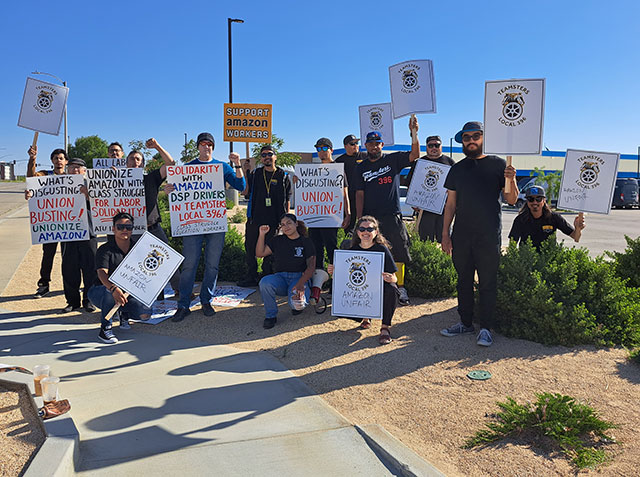
June 28 picket in Palmdale, CA, where Amazon drivers joined Teamsters. Unionizing Amazon will take a massive labor revolt, championing the cause of black workers and immigrant workers, including in the warehouse and transportation hub of Southern California's Inland Empire. (Internationalist photo)
It also key to unionizing Amazon. This will not be achieved on a warehouse-by-warehouse basis, handing in cards to the federal government so that the National Labor Relations Board can hold a representation election. This momentous struggle, which will transform the industry and shake the country, will be done the way the industrial unions were built in the 1930s: through a massive labor revolt. To succeed, such a struggle must champion the cause of black workers, notably in the anti-union bastions of the South, and of immigrant workers, including in the vast network of warehouse and transportation hubs in the Inland Empire in southern California.
The struggle to organize the unorganized – and win real
victories for the unions – means class war against
capitalism. That requires leadership prepared to take on
and defeat the bosses, their parties and their
government. Vote no on the TA at UPS! Strike for
25, and air conditioning now! Organize Amazon with
class struggle! ■
Courtesy
of Democrats, Republicans, Hoffa Jr. and TDU
Union-Suers
How Feds, Dems and Banks Whacked Teamster Pensions
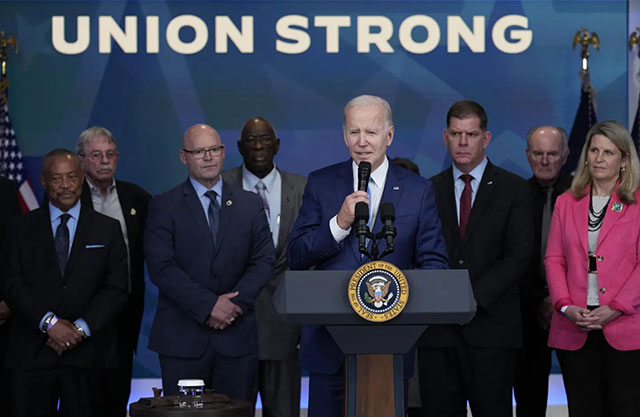
One week after Democrats in the White House and Congress passed strikebreaking legislation imposing no-sick-days contract on railroad workers (three-quarters of them Teamsters) who had voted against it, President Joe Biden announced $36-billion rescue of Central States Pension Fund. Flanking him are Teamster general president Sean O'Brien (to his left) and AFL-CIO president Liz Shuler (right). (Photo: Susan Walsh / AP)
Last December 8, President Joe Biden announced the grant of $35.8 billion in federal funds to shore up the financially troubled Central States Pension Fund (CSPF), covering 350,000 Teamster workers and retirees, mostly in the Midwest. The action came barely a week after the Democratic White House and Congress imposed a contract on railroad workers that they had voted against, and which didn’t include the sick pay they had fought for. The funds came from the $1.9 trillion American Rescue Plan, the coronavirus relief package Biden got passed in 2021. It was the largest pension fund rescue in U.S. history.
Retirees depending on Central States pensions have been demonstrating for federal aid for years. They breathed a sigh of relief as they faced the cutoff of 60% in their benefits, which would have thrown tens of thousands into poverty. The Republicans, of course, denounced the rescue as a “politically inspired payoff” (New York Times, 9 December 2022). The timing was certainly meant to let labor officialdom try to sell Democrats as “friends of labor” in the face of worker discontent over the strikebreaking rail legislation. In making the announcement, Biden was flanked by Teamsters general president Sean O’Brien and AFL-CIO chief Liz Schuyler.
It also meant that there was little chance that O’Brien would cross Biden in a United Parcel Service (UPS) strike this summer. To be clear: current UPS employees are not covered by the CSPF. The company pulled out in 2007, setting up the UPS/IBT Pension Fund covering about 70,000 current employees; others are covered by the Western Conference Teamsters Pension Plan, the New England Teamster Pension Fund and other smaller plans. In the July 25 IBT-UPS tentative agreement, the New England and UPS/IBT plans (which paid lower benefits) will get increased funding, while other plans are essentially frozen, saving UPS many millions.
So how did the Central States Pension Fund come to be so underfunded? Republican spokesman Rep. Kevin Brady blames “union leaders” and trustees who promised too-high payments. (The average CSPF monthly pension is less than $1,200.) The rightist Federalist Society blames mismanagement by Teamster “union bosses.” Wrong on both counts. The No. 1 reason for the tanking of multiemployer Teamster funds was deregulation of trucking under Democrat Jimmy Carter, which led to the demise of many Teamster unions, so today there are five CSPF retirees for every active worker.
Factor No. 2 was the 1982 consent decree that the Teamsters were forced into by Carter’s Labor and Justice departments, with a big assist from Teamsters for a Democratic Union (TDU). In April 1977, International Brotherhood of Teamsters (IBT) president Frank Fitzsimmons was forced by the Carter administration to step down as trustee of the CSPF. Workers Vanguard (No. 158, 20 May 1977), then the voice of revolutionary Trotskyism, ran an article headlined “Hands Off the Teamsters.” WV detailed shady practices of the IBT tops, but stressed: “Breaking union power, not ‘cleaning up the labor movement,’ was the real aim of government intervention.”
TDU, in contrast, hailed the feds’ action, saying that removal of Fitzsimmons was a “little step toward pension reform. So far so good.” Spokesman Pete Camarata said that TDU was “willing to accept government intervention,” that “the union’s so corrupt right now that you need it for a while.” But it’s more than that. The TDU was an instigator of the government attack on the Teamsters. At its national convention in September 1977, it distributed a pamphlet stating:
“TDU is organizing a letter writing campaign to President Carter and Labor Secretary Ray Marshall asking them to use their powers under the Pension Reform Act (ERISA) to remove the current Teamster trustees on the grounds that they have acted in an imprudent manner.”
In May 1978 TDU sued Teamster pensions funds, and in June, when a Congressional hearing was held on the Central States fund, Camarata and another TDUer testified against the union.
This was par for the course for the TDU, which repeatedly ran to the capitalist courts and Labor Department calling to prosecute the IBT. In April 1987, as the Reagan administration was preparing to sue the IBT under the draconian Racketeer Influenced and Corrupt Organizations (RICO) Act, TDU organizer Ken Paff wrote to Assistant U.S. Attorney General Stephen Trott saying, “we strongly urge the government to seek reorganization of the IBT under Section 164(a) of the RICO Act.” The TDU asked for government ordered union elections, and it got its wish. In 1989, U.S. attorney Rudolph Giuliani settled the RICO suit with a court order for the feds to run Teamster elections in 1991 and 1996, and granting federal officers vast powers over the IBT.
The result was the government-supervised election of TDU-backed Ron Carey … and six years later the government ouster of Carey in the wake of, and as reprisal for, the 1997 UPS strike (see “Teamster-UPS Deal: No End to Poverty Wages” on page 1).
Now back to the 1982 consent decree and Central States Pension Fund. Under its terms, a government-named “fiduciary” was granted exclusive power to manage the CSPF plan and invest its assets. The Wall Street investment bank appointed as fiduciary (originally Morgan Stanley) promptly sold off real estate assets – mostly lucrative investments in Las Vegas casinos, which were deemed “troubled” not because they were not profitable, on the contrary, but because they were loans allegedly made to front men for the Mafia who were off-limits to regular banks. Instead, the “professional” money managers invested in “traditional” stocks and bonds.
From 1993, the plan administrators put a majority of CSPF investments in “equity securities” whose value rose and fell with the cycles of the stock market. This intensified from 2000 on, as the fiduciaries (now J.P. Morgan and Goldman Sachs) put two-thirds of the plan’s assets in stocks, a far higher percentage than the average (48%) for multiemployer union pension funds. This continued as Morgan was replaced by Chicago-based Northern Trust. Then came the 2008-09 stock market crash. That led to “Central States’ astonishing 42% drop in assets – and a loss of about $11.1 billion in seed capital – in just 15 months during 2008 and early 2009.”8
As MarketWatch noted, the government and banks “stood watch while the financial markets accomplished what the mob had failed to: which was to smash the fund’s long-term solvency with massive money-losing investments.” Central States never recovered from this devastating loss, which is why a federal rescue was needed to prevent the fund from going under. But so-called “legitimate” investors who stayed invested in Vegas real estate, having pushed out the mob, made out like bandits, so to speak, raking in billions. Even other Teamster pension funds that escaped the feds’ death grip, like the Western Conference fund, managed to stay solvent.
The overall problem of underfunded pension funds was not limited to the CSPF, or the IBT. A 2018 report to Congress by the U.S. Government Accountability Office cited reports by a “prominent actuarial firm” that by 2014, 36% of multiemployer pension funds insured by the Pension Benefit Guarantee Corporation (PBGC) were classified as “endangered” or in “critical” status.9 Something had to be done. The response of the Obama administration and Congress was the bipartisan Multiemployer Pension Reform Act of 2014, whose main purpose was to “save” pension funds by slashing retirees’ benefits. Senate Democrats voted by 2-1 for the bill.
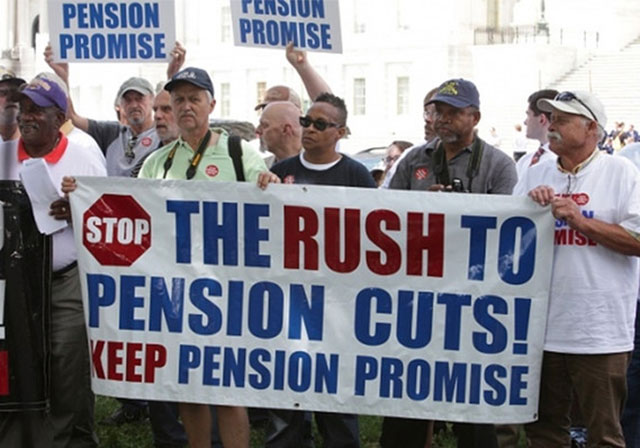
Union retirees have protested for years to defend their pensions. (Photo: teamster.org)
IBT president James Hoffa Jr. originally joined with employers and other union tops in developing a plan to allow such cuts, pulling out at the last minute. Teamsters for a Democratic Union played a leading role in opposing the cuts, but was co-responsible for the government takeover of CSPF that led to the crisis. This union “reform” caucus was started by the International Socialists (I.S.), heirs of the anti-Trotskyist renegade Max Shachtman. In his book praising the TDU, Rank and File Rebellion (1990), fellow Shachtmanite Dan La Botz wrote:
“The TDU pension reform campaign was largely successful…. [P]artly as a result of TDU’s pressure, the Carter administration used the power of the federal government to clean up the Central States Pension Fund, removing the gangsters and stopping the poor investment practices of the past.”
The social-democratic TDU appealed to the capitalist government to “clean up” the IBT. As a result, the feds whacked the funds and endangered the livelihoods of Teamster workers.
This is not an apology for the IBT Old Guard, far from it. Many of them – but not all – were in bed with the mob. They are the heirs of Teamster chief Dan Tobin who brought in the government to prosecute and jail the Trotskyists who led the greatest Teamster battle in history, the 1934 Minneapolis strikes that laid the basis for Teamster power. The bedrock of that power was independence from the bosses, their politicians, their government and their state power. Among the thugs Tobin sent to Minneapolis to battle the militant Teamsters was a young Jimmy Hoffa, who had been part of the Central States Drivers Council led by Trotskyist Farrell Dobbs.
The story of the Central States Pension Fund comes down to basics. The Democrats (and Republicans) are no “friends of labor” but bosses’ parties. The government is not neutral, it is the executive committee of the bourgeoisie whose task is to suppress the exploited and oppressed. Appealing to the cops, courts and bourgeois politicians is crossing the class line, betraying the workers by bringing in the class enemy. Marxists and class-struggle labor militants oppose government intervention in union affairs, including laws claiming to defend union democracy, and we defend the unions, however corrupt, against the capitalist state. Bottom line: labor must clean its own house.
It should be obvious that no private pension funds, whose income derives from investments, are safe from destruction by financial pressures under capitalism. Even supposedly guaranteed Social Security funds can be gutted, their wholly inadequate benefits slashed, their coverage limited and their assets raided by bourgeois politicians out to improve the “competitiveness” (profitability) of capital. This is being dramatically demonstrated by the sharp battles over pensions in France, from 1995 to today.10 Only by mobilizing the power of the workers in all-out class struggle can we defeat the forces who would condemn millions to toil until they die.
Social gains of the past – the 8-hour day, 40-hour workweek, pensions, public health and education – are being ripped up before our eyes as decaying capitalism only invests in frenzied speculative bubbles and job-destroying technology. A secure retirement for the millions can only be won by building a class-struggle workers party fighting for international socialist revolution. Then, instead of condemning those who can no longer produce profits for the bosses to poverty and dreary warehouses for the elderly, a society freed from the deadly profit drive can come up with creative means to ensure a comfortable and rewarding existence for all. ■
- 1. The provision was introduced under Teamster then-president Dan Tobin, as part of a series of measures to grant himself dictatorial powers over the union in the middle of a fight with the Trotskyist-led Minneapolis Teamsters.
- 2. See “Democratic Party Strikebreakers Shackle Railroad Workers,” The Internationalist No. 69-70, January-May 2023.
- 3.“Vote ‘No’ and Escalate the Fight to Win a Strong Contract!” (28 July). SAlt is part of the International Socialist Alternative tendency.
- 4.Tempest (founded by former leaders of the defunct International Socialist Organization) was quite active among the several currents present in the DSA in the past (2019-21), but has since largely left, although some Tempest members are still in it.
- 5. “What happened to the big UPS Strike?” originally published by CounterPunch (28 July).
- 6. See “Thousands of Rail Workers Railroaded by Teamsters Bureaucracy” (11 November 2022); “The Case for a Socialist Rank-and-File Teamsters Organization” (10 June); and “The Part-Time Fight for $25 at UPS and the Betrayal of TDU” (21 July).
- 7. In the drive to unionize workers at the Amazon facility in Bessemer, Alabama in early 2021, the WSWS called to “Vote ‘No’ to the UFCW-backed union at Alabama Amazon facility!” (see our exposé “How the ‘World Scab Web Site’ Aids the Bosses,” The Internationalist No. 62, January-March 2021).
- 8.“How the Teamsters pension disappeared more quickly under Wall Street than the mob,” MarketWatch, 6 April 2016.
- 9. GAO, “Central States Pension Fund: Investment Policy Decisions and Challenges Facing the Plan” (June 2018).
- 10. See the program for “All-Out General Strike to Shred the French Pension ‘Reform’,” in our article “France: Drive Out Macron, Fight for a Workers Government,” The Internationalist No. 69-70, January-May 2023.